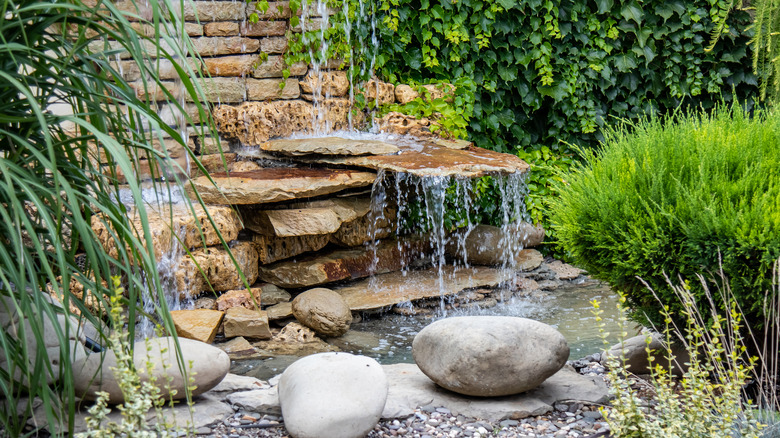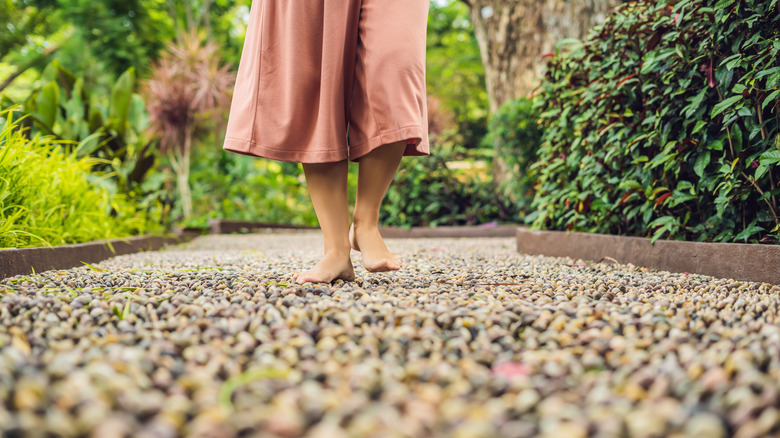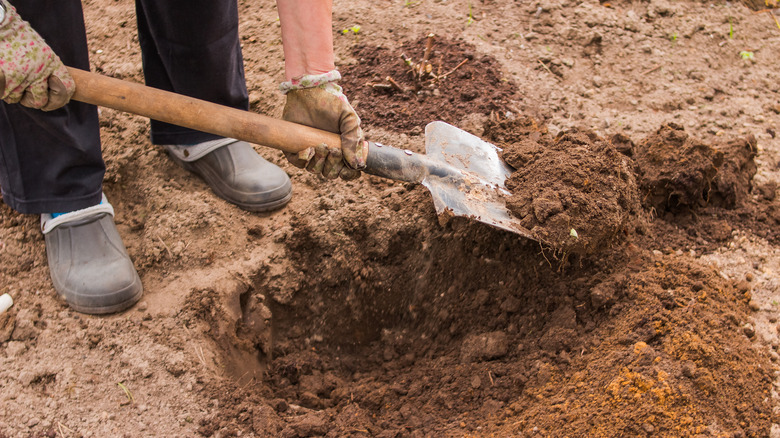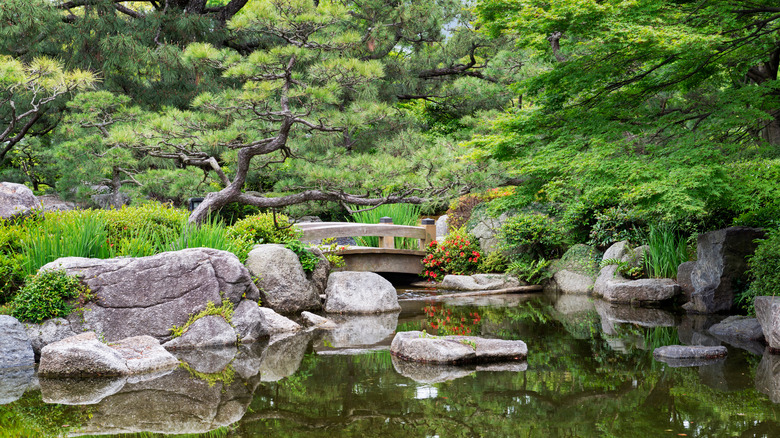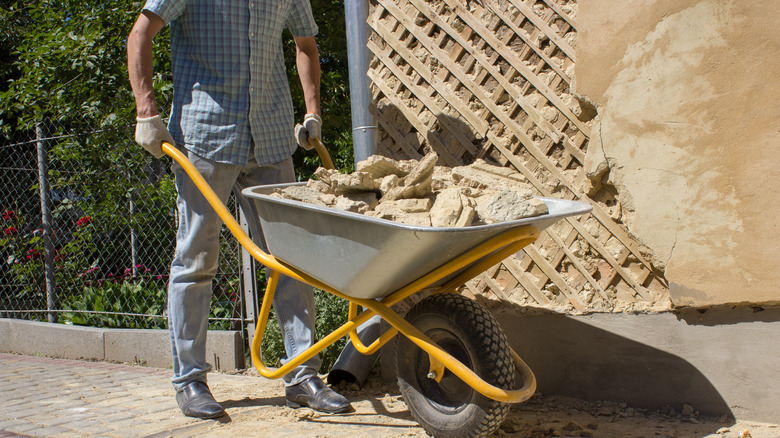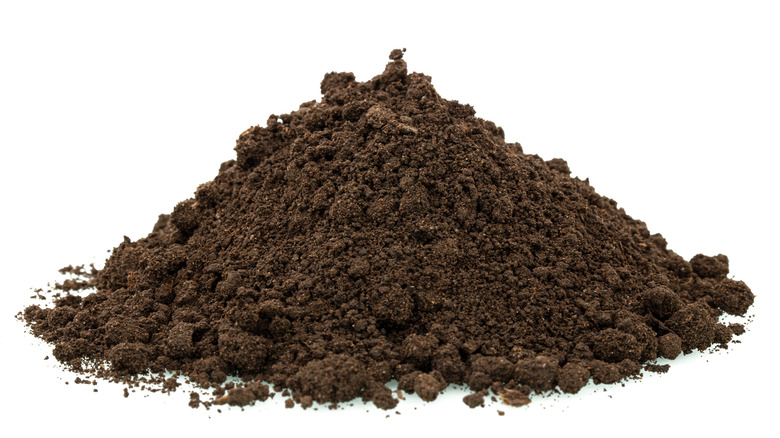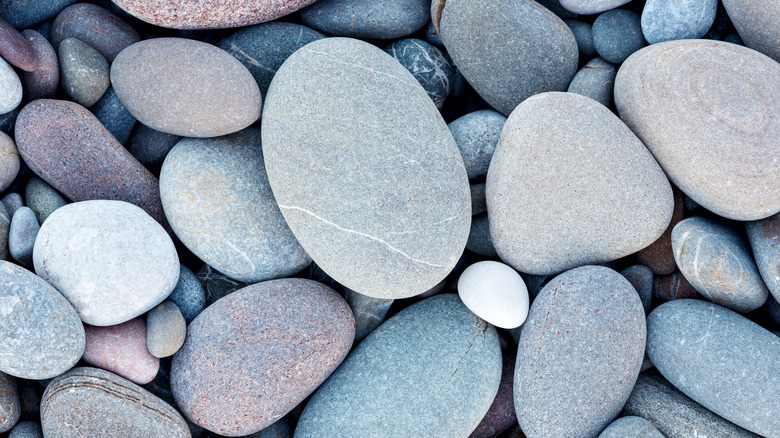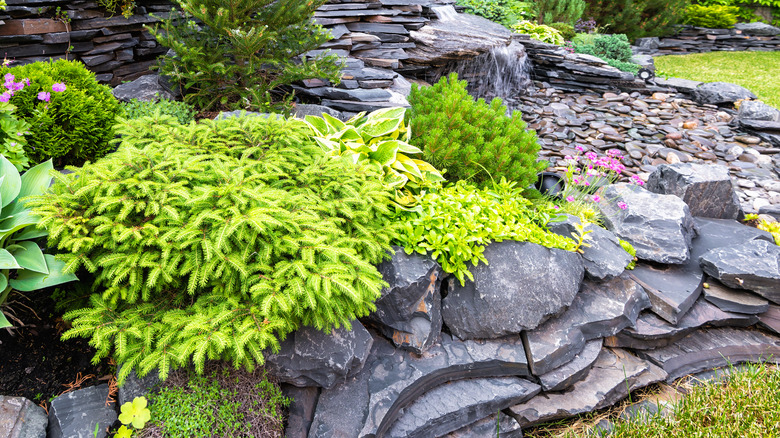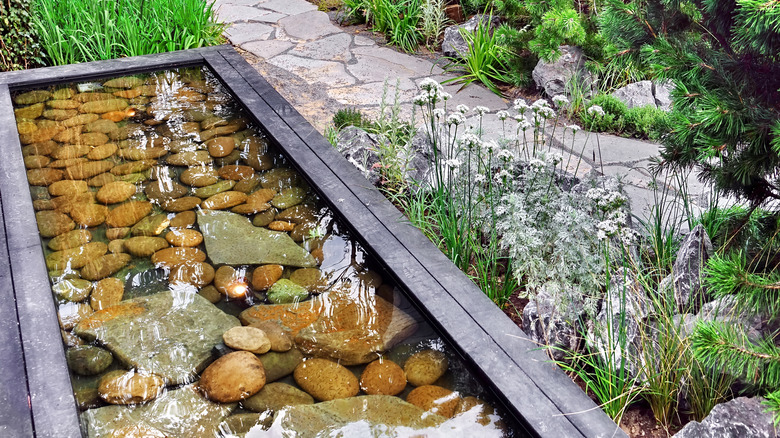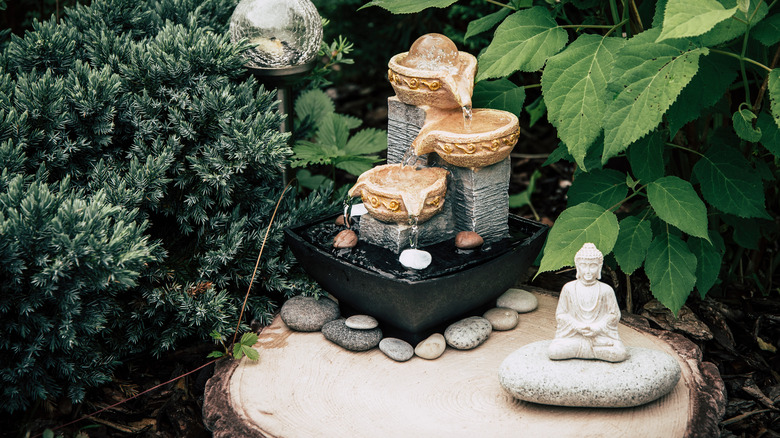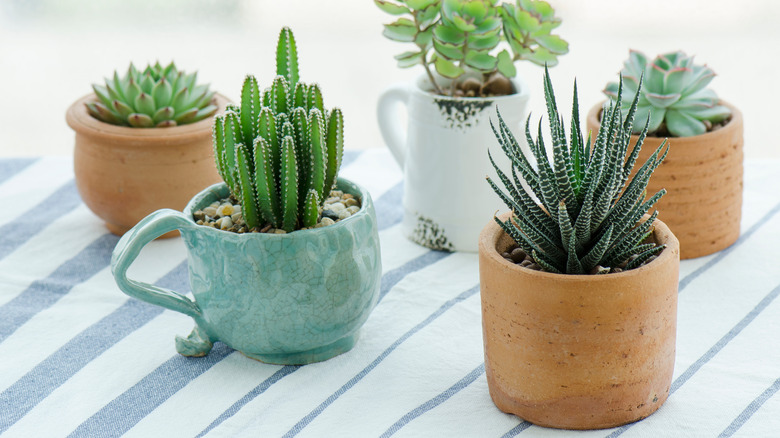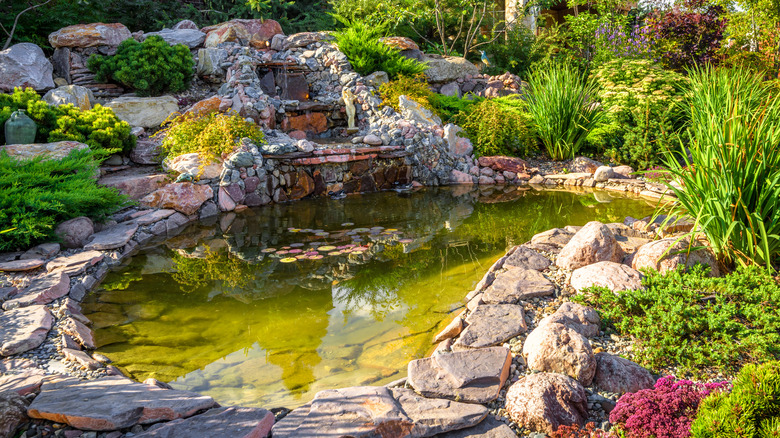15 Easy Tips For Designing A Rock Garden
When it comes to deciding on how to landscape your yard, there are a lot of things to consider. Some homeowners with green thumbs might be enthusiastic about the idea of filling their yard with all kinds of plants and flowers — however, if you're not much of a gardener and don't relish the maintenance that comes along with having a garden, low-maintenance options like rock gardens may be a better fit.
There are a ton of benefits to opting for a rock garden in your yard. First of all, a rock garden allows you to craft a thoughtfully-designed yard that can withstand any weather conditions. Unlike plants, or even grass, it doesn't matter if the sun beats down relentlessly on a particular area of your yard, or if your community is experiencing a serious dry spell. It's also ideal for yards that have problematic areas, as Pinehurst Landscape Company explains. You can arrange rocks over spots in your yard that struggle to sustain growth, or that are uneven. Finally, you can find a wide variety of styles that match your aesthetic, and can even play around with different sizes, textures, and colors of rock to create a truly showstopping look. According to Contemporist, it can even make your yard feel larger, a huge plus for those with smaller yards.
If you've decided to invest in a rock garden for your yard, here are 15 easy tips to ensure you get your ideal slice of rocky paradise.
1. Gather inspiration
It can be challenging to envision exactly what you may want your rock garden to look like, which is why doing research and gathering inspiration is so crucial, as Garden Design explains. Visit some public gardens in your area or scour the internet for pictures that speak to you. Based on the inspiration you gather, you should be able to look through to identify certain features, materials, or layouts that seem to appeal to you.
2. Clear the area
This step will depend on what your yard is like starting out, but chances are, you'll have to do some clearing, according to DIY Network. You'll want to remove any plants, bushes, and vegetation such as leaves or twigs. You want to dig things up below the roots, as The Spruce explains, to ensure that unwanted shoots don't end up peeking through your rock garden later on. This step may seem like it doesn't matter, but it's essentially laying the foundation for your rock garden.
3. Plot your design out first
As Backyard Boss clarifies, a lot of the materials for a rock garden are quite heavy, so you want to have a good idea of where everything will be going before you actually begin moving it around. After all, you don't want to haul endless wheelbarrows full of rocks, only to realize you need them in an entirely different spot. You may not be a professional landscape architect, but you can sketch out a rough idea of what you want the finished product to look like.
4. Determine the overall style you want
Within the world of rock gardens, there's a huge amount of variety in style, as Planted Well demonstrates. One of the important early steps in designing a rock garden is to determine the overall aesthetic you want it to have. Do you want something Zen, with a minimalist feel? Or do you want it to feel more rustic, as though your backyard is a forest? Do you want smooth, polished stones or natural ones with jagged edges? Whatever your preference, try to nail down a few main descriptors so your overall design feels cohesive.
5. Find out what's native to your area
While you're certainly free to use whatever type of rocks you love in your garden, incorporating rocks that are native to your area can help make your garden really fit into the landscape and give it a certain amount of cohesion, as The Spruce explains. As an added bonus for those on a budget, typically rocks native to your area will be less expensive, since they don't have to be shipped as far.
6. Determine your source or supplier
As Hunker clarifies, one of the most important steps in designing your rock garden is finding the source or supplier where you'll actually get the rocks — typically a quarry, or landscape or garden center of some sort. You can purchase them in varying quantities depending on what you need, from 40 pound bags for accent areas to 2,000 pound bags for larger swaths of land (via Home Depot). Often, the details will include the measurement of cubic feet that the amount of rocks in that particular package will cover so you'll have an easier time determining how much you need to buy.
7. Get some tools
The reality is, you just can't move rocks around the same way you would move flowers or plants. Depending on the size of the rocks you've selected, you may want to consider getting tools such as a back brace, shovel, and wheelbarrow, or even a two-wheel dolly, as The Spruce suggests. If you're including oversized boulders as part of your design, you may even want to look at hiring a contractor or using some type of power equipment to deal with the really heavy rocks.
8. Use the right kind of soil
While you might assume soil is only important if you're planting items like flowers, that's not the case at all — as Country Living explains, soil matters in your rock garden as well. Avoid nutrient rich soil packed with compost for this particular purpose, and instead, use a blend of sand, small rocks, and lean topsoil to lay the foundation for your rock garden to thrive.
9. Decide on a color scheme
Whether you're adding rocks or plants, the color scheme is a key consideration for your garden, as Backyard Boss reports. There are rocks available in a wide variety of colors, and you'll want to think of how they all work together in your overall design plan. Incorporating seven different shades in a small backyard will likely end up looking cluttered and chaotic, for example. Pick an overall color scheme to work within, whether that's neutral ivory stones or shades of deep gray, and factor in how things like added plants or different accessories can help accentuate it.
10. Incorporate a variety of sizes
Unless you're going for a super minimalist feel, selecting just one size of rock will likely create more of an industrial look in your rock garden. As Country Living suggests, you want to play around with scale and include a variety of different sizes of stones in order to create a natural-looking, eye-catching design. This may mean placing a few larger rocks as statement pieces in an area filled with smaller pebbles, using large stone slabs as a walking path between areas in your yard, etc.
11. Think natural when placing and arranging your rocks
Now, if you're all about symmetry and want a highly designed rock garden, that's completely fine — your yard, your choice. However, a rule of thumb that The Spruce explains is that you should try to arrange your rocks in a way that looks natural. This could include incorporating elements like elevation or slopes, ensuring any visible striations in your rock are aligned, or taking an asymmetrical approach to your arrangement.
12. Add in some accessories
Just like you'd incorporate various accessories and décor items inside your home, you want to get creative with your yard; bring in a few elements beyond just the variety of rocks and stones you've selected, as Hunker suggests. This gives you a place to really allow your personality to come through in your space as well. Consider adding items like sculptures, outdoor lighting, trellises, decorative pots, feeders for wildlife you may want to attract, etc.
13. Consider incorporating a few plants
You may have selected a rock garden specifically because you don't have a green thumb, but that doesn't mean you can't have any greenery whatsoever. Typically, as Country Living demonstrates, the types of plants that do well in rock gardens tend to be very low-maintenance, drought-resistant species that thrive without much water. Depending on the look you're going for, you may want to consider succulents for that desert vibe, creeping plants such as moss for more of a forest feel, ornamental grasses, or specific plants like thyme or rock cress that do well amidst rocks (via Rhythm of the Home).
14. Level up with a water feature
There's no denying that adding a water feature can be tricky and involve a lot of work, but for those who really want a serene, Zen vibe in their rock garden, it can make a major impact, as Homes & Gardens reports. This could include simple water features like a birdbath, or more complex options that require electricity, such as fountains. Make a serious statement with designs like a water wall, or if you have enough square footage in your yard, you may even want to invest in your own pond.
15. Establish your garden
You may assume that you just leave your rock garden alone after installing everything, but that's not quite the case, as HGTV explains. In those critical beginning stages when your rock garden is still fresh, you'll want to water it frequently until everything gets established — once that happens, all you'll really need to do in order to maintain your garden is some occasional weeding.
